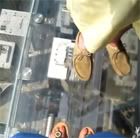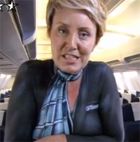 Airline performance is at a four-year high according to a recent study by private researchers. The study, which is based on government statistics, examines factors like the timeliness of flights, number of lost bags, and the percentage of passengers who file complaints to determine overall quality.
Airline performance is at a four-year high according to a recent study by private researchers. The study, which is based on government statistics, examines factors like the timeliness of flights, number of lost bags, and the percentage of passengers who file complaints to determine overall quality.
Of the 17 airlines researched, Hawaiian Airlines took first place, followed by Airtran Airways and Jet Blue. American, Continental, Delta and United were all in the middle with regional airlines filling out the bottom third.
The study found consumer complaints dipped from 1.42 per 100,000 passengers in 2007 to 1.15 in 2008. Southwest Airlines had the best rate, only 0.25 complaints per 100,000 passengers; US Airways had the worst rate, 2.25.Although airlines have made strides to improve customer experience, the reduced number of travelers has had the most significant impact in reducing lost bags and bumped ticket-holders. Aviation experts say the world's air transport system had reached capacity in 2007 (the year airlines did the worst in this study) and now, due to decreased travelers, things are starting to improve.The average on-time performance last year was 3 percentage points better than the year before, yet nearly one-quarter of all flights were late. The study said 12 airlines improved from the previous year, but only three airlines had better than an 80% on-time rate: Hawaiian, 90%; Southwest, 80.5%; and US Airways, 80.1%.
American, the nation's largest air carrier as measured by passengers flown the most miles, had the worst record, arriving on time only 69.8% of the time.
Dean Headley, aviation expert and co-author of the study argues that now's the to improve our air transportation system.
He urged Congress to take advantage of this "breathing room" to move forward on a system that would replace decades-old radar technology with satellite-based technology.
That new system is forecast to increase air transportation system capacity by enabling planes to fly closer together and more directly to their destinations, saving time and fuel.
"It's crazy to think we can keep going the way we were going with the volume of planes we have in the air," Headley said.




 PTG 'casually' hangs out in the world's biggest building
PTG 'casually' hangs out in the world's biggest building Air New Zealand's Bare Essentials
Air New Zealand's Bare Essentials Rapping Flight Attendant Explains GAAP
Rapping Flight Attendant Explains GAAP Bad Idea Jeans: turning away passengers who exhibit swine flu symptoms.
Bad Idea Jeans: turning away passengers who exhibit swine flu symptoms.
0 comments:
Post a Comment